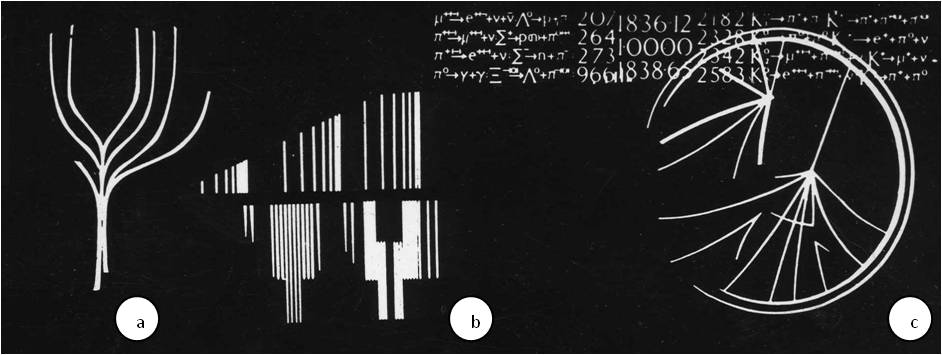Located high above our heads over the Blackett laboratory entrance is a large relief sculpture that often goes unnoticed. The sculpture was installed in 1958 when the building was opened. The content is a colourful assortment of the state of physics knowledge at the time: nine images and four blocks of densely packed equations and scientific data - some expressed in ways that would not be familiar to contemporary physicists.
There seems to be very little information about the work in the college archives, except to say that the sculpture in Irish limestone is by John Skeaping who was Professor of Sculpture at the RCA at the time and most known for his images of horses.
Various conversations in recent months have decoded the work. I have had the great pleasure of talking with Tom Kibble and Norman Barford who were present in the department when the sculpture was installed. Others have also helped - Andrew Jaffe, Chris Phillips, Steve Rose, Lady Anne Thorne. We are left with one outstanding point which is the identification of the spectral lines - we wonder if they are too stylised to recognise.
Our results are recorded below against sections of the original design. We deal with the nine images first and then the texts. Thank you to everyone who helped, with particular thanks to Tom and Norman.
Images
a. Laminar fluid flow around a smooth object. b. Spectral lines – various series. Not identified. c.Bubble chamber picture. The reaction was probably the production of neutral particles: Lambda-0 and a K0 particle, so do not show up as visible tracks, but decay into pairs of charged particles (possibly with an extra neutral one), so they show up as V shapes, pointing back towards the initial scattering vertex.
a. Magnetic or electric dipole aligned with the horizontal axis, showing connecting field and crossing equipotential lines. b. Screw dislocation possibly related to semiconductors. Maybe silicon carbide.
a. Alpha particles in a helium filled cloud chamber. The forking tracks are scattering of the alphas and helium nuclei which have the same mass. Probably based on pictures taken by Blackett. b. A crystal lattice, possibly GaAs. c. Larmor precession - symbolic representation of the effect of a magnetic field on an electronic orbit.
Text
The densely packed characters in the carving are separated by a colon every time the subject changes. The same format is used in the descriptions.
a. There are two different decays on each line -- not only the decays of the mesons but also those of the strange baryons: Lambda0, Sigma+, Sigma- and Xi-. (These are the commoner decay modes; there are others.) b. Masses of proton, electron and neutron in electron masses. c. Here again there are two decays in each line, all of them decays of the strange mesons (kaons), K+/- and the two varieties of K0. d. The masses (in terms of electron masses) of mu+/-, pi0, pi+/- and K+/-. e. The masses of Lambda0, Sigma+, Sigma- and Xi- (in terms of electron masses).
a. Newton’s law of gravitation: Saha Boltzman equation: Ratio of the gravitational and electromagnetic forces between an electron and proton: Kepler’s period of an object moving elliptically about the sun with semi major axis ‘a’: Energy and momentum of relativistic particle. b. Newton’s Gravitational Constant: Diffraction: Intensity of Rutherford Scattering at angle theta: Ideal Gas Law: Entropy applying to the statistical mechanics of any system (carved on Boltzman’s burial stone). c. Energy of relativistic particle of mass mo: Relationship between specific heat at constant pressure and that at constant volume where g is the Gibbs free energy (old fashioned notation): Bose Einstein (-) and Fermi Dirac (+) statistics: Curie’s law for magnetic susceptibility at low temperatures: General equation to show how a classical path minimises action.
a. Maxwell’s laws of electricity and magnetism. b. Calculation of the electromotive force (v) in a circuit: The force on a charged particle in a magnetic field. c. This is a relation between two solutions, φ and ψ of the Schrödinger equation. The second equality, between volume and surface integrals is what is sometimes called Green's second theorem. ds is an element of surface area, and dτ an element of volume. The volume integral is over some volume V and the surface integral over its bounding surface. dn is a spatial derivative in the normal direction. d. All relate to electromagnetism: D is the electric displacement vector: B is the magnetic field: Continuity equation for energy conservation. Energy dissipation is allowed for and represented by the last term E.j.
a. Schrodinger equation: Commutation relation between p and q: De Broglie: Mass of electron: Energy of a photon: A peculiar way of writing the Dirac Equation - β is the Dirac matrices b. 1s wave function in a hydrogen like atom of Bohr radius a0: Speed of Light: Bohr’s relation for the frequency of light emitted by hydrogen: Fine Structure Constant: Compton Scattering. c. Heisenberg’s Uncertainty Principle: Black body radiation: Fusion of deuterium and tritium to make Helium and energy release: Planck’s constant: The Born Rule.







